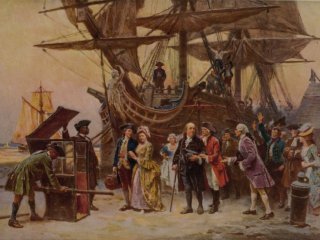
- Description
- Objectives
- Outline
- Materials
- System Requirements
- Watch a Demo
This course introduces you to World History by exploring the evolution of societies and civilizations from the dawn of mankind up to the year 1800. We start by discussing man’s ancient ancestors, the formation of complex societies, and the rise of empires. We then move on to discuss the rise and fall of the major societies in Europe, Asia, the Middle East, and India. We conclude with an exploration of aspects of the early modern era and emergence of new world patterns.
Prerequisite: None
After completing this course, you should be able to:
- Define how human beings evolved to form complex societies
- Differentiate between the ancient cultures of Africa, Europe, Asia, and the Americas
- Identify how conquest, religion, and innovation led to social change during the Common Era
- Describe aspects of new patterns of civilizations
- Recognize the fundamentals of expansion and reform
World History I Module 1
Dawn of Early Civilizations
- The First Humans
- The Emergence of Civilization
- Civilization to Mesopotamia
- Egyptian Civilization
- New Centers of Civilization
- Rise of New Empires
World History I Module 2
Early Civilizations of India and China
- Aryans in India
- Religious World of Ancient India
- Indian After the Mauryas
- Indian Culture
- The Zhou Dynasty
- The Qin Dynasty
- The Glorious Han Dynasty
- Daily Life in Ancient China
- Chinese Culture
World History I Module 3
Greek Civilization and The Roman World Empire
- Early Greece
- Greek City-States (ca. 750 – ca. 500 B.C.E.)
- Classical Greece
- The Rise of Macedonia
- Conquests of Alexander
- The World of Hellenistic Kingdoms
World History I Module 4
The Americas and the Middle East
- The Peopling of the Americas
- Early Civilizations in Central America
- The First Civilizations in South America
- Stateless Societies in the Americas
- The Rise of Islam
- The Arab Empire and Its Successors
- Islamic Civilization
World History I Module 5
Early Civilizations in Africa, South and Southeast Asia
- The Coming of Islam
- States and Noncentralized Societies in Central and Southern Africa
- African Society
- African Culture
- The Silk Road
- The Arrival of Islam
- The Golden Region: Early Southeast Asia
World History I Module 6
China and the East Asian Rimlands
- China After the Han
- The Sui, the Tang, and the Song
- The Mongol Empire
- The Ming Dynasty
- The Apogee of Chinese Culture
- Japan
- Korea
- Vietnam
World History I Module 7
Europe and the Byzantine Empire
- Emergence of Europe in the Early Middle Ages
- Europe in the High Middle Ages
- Medieval Europe and the World
- From Eastern Roman to Byzantine Empire
- The Zenith of Byzantine Civilization (750 – 1025)
- The Decline and Fall of the Byzantine Empire (1025 – 1453)
- The Crises of the Fourteenth Century
- The Renaissance
World History I Module 8
Emergence of New World Patterns
- An Age of Exploration and Expansion
- Portuguese Maritime Empire
- The Conquest of the “New World”
- Africa in Transition
- Southeast Asia in the Era of the Spice Trade
- Europe in Crisis, 1560 – 1650
- The Practice of Absolutism
- England and Limited Monarchy
World History I Module 9
Muslim Empires and the East Asian World
- The Ottoman Empire
- The Safavids
- The Grandeur of the Mughals
- China at Its Apex
- Changing China
- Tokugawa Japan
- Korea and Vietnam
World History I Module 10
New World Order
- An Intellectual Revolution in the West
- Economic Change and Social Order
- Colonial Empires and Revolution in the Americas
- New Political Order and Global Conflict
- French Revolution
- The Age of Napoleon
**Outlines are subject to change, as courses and materials are updated.**
Ed4Career is committed to being both environmentally conscious and making it easier for you to study! We’re making your education mobile! All of our textbooks are now provided as eTextbooks. You can access them on your laptop, tablet, or mobile device and can study anytime, anywhere.
The move away from physical books to eTextbooks means you get the latest, most up-to-date version available. This also makes your training more accessible, so you can study anywhere you have your phone or tablet. The best part is that all materials are included in your training cost so there are NO extra fees for books!
Internet Connection
- Broadband or High-Speed - DSL, Cable, and Wireless Connections
*Dial-Up internet connections will result in a diminished online experience. Classroom pages may load slowly and viewing large audio and video files may not be possible.
Hardware Requirements
- Processor - 2GHz Processor or Higher
- Memory - 1 GB RAM Minimum Recommended
PC Software Requirements
- Operating Systems - Windows 7 or higher
- Microsoft Office 2013 or higher. Also, you could use a general Word Processing application to save and open Microsoft Office formats (.doc, .docx, .xls, .xlsx, .ppt, .pptx)
- Internet Browsers - Google Chrome is highly recommended
- Cookies MUST be enabled
- Pop-ups MUST be allowed (Pop-up Blocker disabled)
- The Kindle Reader App or VitalSource Bookshelf App are needed for many of our courses (No special equipment needed. This can be downloaded for FREE onto your computer.)
- PowerPoint Viewer (if you do not have PowerPoint)
- Adobe PDF Reader
- QuickTime, Windows Media Player &/or Real Player
MAC Software Requirements
- Operating Systems - Mac OS x 10 or higher with Windows
- Mac office programs or a Word Processing application to save and open Microsoft Office formats (.doc, .docx, .xls, .xlsx, .ppt, .pptx)
- Internet Browsers- Google Chrome is highly recommended
- Cookies MUST be enabled
- Pop-ups MUST be allowed (Pop-up Blocker disabled)
- The Kindle Reader App or VitalSource Bookshelf App are needed for many of our courses (No special equipment needed. This can be downloaded for FREE onto your computer.)
- PowerPoint Viewer (if you do not have PowerPoint)
- Adobe PDF Reader
- Apple QuickTime Media Player
